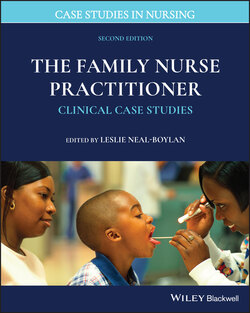Читать книгу The Family Nurse Practitioner - Группа авторов - Страница 41
ОглавлениеCase 4.10 Food Allergies
By Allison Grady, MSN, APNP
SUBJECTIVE
James is a 5‐year‐old male who presents to his pediatrician after being seen in the emergency room 2 days prior for hives and trouble breathing after eating a peanut butter and jelly sandwich. His mother reports that James has had peanut butter before and would occasionally cough but has never had any skin changes that she can remember and certainly never had trouble breathing. She wonders whether he was choking on the peanut butter instead of having an allergic reaction but concedes that he turned red and was gasping for breath. He was also found to have hives all over his back and trunk. “No one in our family has a peanut allergy and it’s basically all that his older brother eats. It would be a real problem if we couldn’t have it in the house.” The provider explains to the mother that James recovered from his episode after receiving a dose of epinephrine, which would not have helped if he was choking, and hives are not caused by simply coughing. The provider asks if James has had any peanuts since the incident and mother says “no.” James has also not had any further episodes of hives or respiratory distress since being discharged from the hospital. His mother grudgingly agrees that it probably wasn’t choking, but asks “Are you sure that this was an allergy? Could we get him tested or something? What do we in the meantime?” She holds up the EpiPen that she was given at the hospital: “I don’t want to carry this around all of the time and James isn’t old enough to know how to use it.”
Birth history: James was born via normal, spontaneous vaginal delivery at 42 weeks. He weighed 10 lbs, 1 oz. He did not spend any time in the neonatal intensive care unit (NICU) and was discharged to home with his mother at 2 days of life.
Social history: James lives with his mother, father, 8‐year‐old brother (Kevin), and 1‐year‐old sister (Kyla). James attends full‐day kindergarten at a local public school. The family has 2 cats and a fish.
Diet: James is considered “overweight” by BMI, but is an active child with a lot of muscle. He plays soccer in the fall and baseball in the spring and summer. He has a total of 1 hour of recess per day at school. He eats a variety of foods, including grains, fruits, andvegetables, and his main protein sources are peanut butter and chicken. He drinks 8 oz of juice per day and about 12 oz of milk per day.
Elimination: James has no history of constipation and no history of urinary tract infection (UTI).
Sleep: James has an inconsistent bedtime routine, but generally goes to bed around 8 p.m. on school nights and wakes up at approximately 6 a.m. On the weekends, he is often up until 10 p.m. but still wakes up around 6 a.m.
Family medical history: James’s father has lactose intolerance and James’s mother has a history of eczema. Maternal grandmother: history of breast cancer (still living); paternal grandmother: hypertension (on medications); maternal grandfather: prostate cancer (still living) and Type 2 diabetes; paternal grandfather: deceased from heart attack at age 62; maternal aunt: history of celiac disease; paternal aunt: history of hypothyroid; paternal uncle: history of depression.
Medications: James does not take any medications.
Allergies: James has no known drug allergies but may have a peanut allergy.
OBJECTIVE
Vital signs: Heart rate is 110; respiratory rate is 13; oxygen saturation is 100% on room air; blood pressure is 98/62. Denies any pain.
General: Well‐appearing 5‐year‐old child, appears masculine in dress and manner. He is in no distress.
HEENT: Normocephalic head with no appreciable lumps or bumps. Eyes demonstrate ability to fix and focus, pupils are equal, round, and reactive to light. Ears are set proportionately to head. Tympanic membranes are visible with no evidence of infection (no pus/fluid/erythema). Trachea is midline. Thyroid is appropriate in size. Mucous membranes are moist. Dentition demonstrates 1 loose tooth and 1 missing tooth. All primary teeth at this time.
Cardiovascular: Regular heart rate and rhythm. No rubs, murmurs, or gallops heard.
Respiratory: Lungs clear to auscultation in all fields. No wheezes, rhonchi, or rales.
Abdomen: Soft, nontender, nondistended. Normoactive bowel sounds are present in all four quadrants.
Gastrointestinal/Genitourinary: Deferred.
Neurological: Grossly intact. Demonstrates grossly normal hearing, vision, balance. No abnormal gait observed.
Musculoskeletal: All 4 extremities move equally with appropriate strength and range of motion.
Skin: Color is appropriate for race; no pallor. No rashes or hives noted. Patch of mild eczema on left lower extremity. Temperature and texture otherwise within normal limits.
CRITICAL THINKING
1 What are the top three differential diagnoses? What testing will confirm the diagnosis?
2 How should the provider educate the mother about the seriousness of anaphylaxis and the risk of it occurring again?
3 How can the provider help the school manage a child with food allergies?
4 If this family does not have insurance, what is the expected out‐of‐pocket expense for an EpiPen? Likely more than one will be needed, so how can a family navigate this barrier?
5 What is the essential information that all caregivers (not just parents) need to know when caring for James?
6 What advice should the mother be given regarding introduction of peanut‐based products to the youngest child now that food allergies are known to be in the family?
